Special Mid-Month Issue June 15, 2012 |
|---|
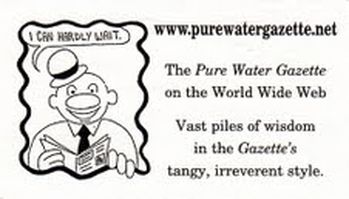 http://www.purewatergazette.net http://www.purewatergazette.net |
|---|
Mid-month Occasionals do not normally contain water news items, but we're including a few with this issue to bring attention to the Pure Water Gazette's new "Today's Top Water Story" section. New articles appear daily. Some examples of recent posts are below. |
Post-Civil War Embalmers Pumped Corpses Full of Arsenic. Now The Arsenic Is Turning Up In Groundwater.
 |
|---|
From the time of the Civil War to the first decade of the 20th century, arsenic was the main ingredient of embalming fluids in the United States. Arsenic does not degrade, ever, into harmless by-products, so the burial practices of the end of the 19th century and first years of the 20th have left us with significant environmental hazards. To be clear, we aren’t talking about minute amounts of arsenic. Embalmers often had their own special fluid blend, but they usually used from as little as four ounces to as much as 12 pounds of arsenic per body. As caskets downgrade, the arsenic is picked up by water moving downward and washed into the soil or the groundwater. |
Filter-Toting Woman Caused Airport Terminal Evacuation
Yet another airport terminal was evacuated when a water filtration device was discovered in a passenger’s luggage. In a recently reported incident, a man was arrested for transporting drugs on an airplane inside a water filter.
In the present case, the woman passenger, who had boarded a plane at the Minneapolis airport with a water filter in her luggage, was not arrested. The water purification device was detected during bag checking and the Bloomington Police Department bomb squad was called in for investigation.
Water and Electricity Go Hand In Hand. How A Shortage of Cold Water Creates A Shortage of Electricity
Climate change is bad for electricity supplies. It takes electricity to process and deliver water, and it takes water to make electricity. What affects one side of the equation affects the other.
We burn coal or natural gas to boil water to turn turbines to produce electricity. Turbines produce more than 90 percent of our electricity.
Power generating plants are cooled by water in rivers or lakes. As lake and river water get warmer, and less abundant because of global warming brought on by the greenhouse gases produced by running the turbines, it gets harder to cool the plant and electrical production has to be cut back.
According to Scientific American, by 2040 electrical production may fall as much as 16 per cent in the summer, when we need it most for air conditioning.
More about this from Scientific American.
Fort Peck Dam, Like Many US Dams, Needs Repairs that the Nation Cannot Afford
Proposed repairs to bolster Montana’s Fort Peck Dam following epic flooding along the Missouri River last year would cost more than $225 million, according to cost estimates released in 2012 by the U.S. Army Corps of Engineers.
But with money short, Corps officials acknowledged they are able to afford only $46 million for damage assessments and repair work for now. Most of that will be spent on repairs to the dam’s spillway.
Dams, which often seem like a good idea when they’re in the planning stage, eventually become fiscal liabilities that will need expensive repairs and even more expensive decommissioning. In the overall scheme of things, even the most impressive dams don't last long.
America’s Aquifers Are Threatened by Over-pumping and Pollution. Should we have an "Endangered Aquifer" List?
Twenty percent of US water for drinking, crop irrigation and everything else comes from underground water. We seldom think of aquifers as being “endangered,” but that is actually the case, as we continue to overuse their water and pollute them with chemicals.
The great Ogallala Aquifer, beneath the Great Plains, supplies 27% of the nation’s farmland with irrigation water. It has undergone decades of depletion through overpumping.
The Central Valley aquifers of California are also being rapidly depleted to supply the nation’s fruit and vegetable demand.
The mighty aquifers that supply New York and New Jersey are being drained and polluted.
Among the suggested aquifer-friendly actions we can take are “curbing fertilizer and pesticide use, responsibly disposing of pharmaceuticals and hazardous waste rather than flushing them down the drain, maintaining septic systems to reduce nitrogen pollution, and protecting open space to promote rainwater infiltration and aquifer recharge.”
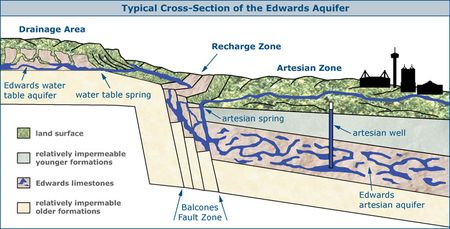 |
|---|
Edwards Aquifer That Lies Beneath a Large Portion of Central Texas |
Green Energy Experimenters in Oregon Are Pumping Millions of Gallons of Water into Newberry Volcano
In an ambitious plan being undertaken in Oregon, geothermal energy developers plan to pump 24 million gallons of water into the side of a dormant volcano to demonstrate new technology they hope will give a boost to a green energy sector.
They hope the water comes back to the surface fast enough and hot enough to create cheap, clean electricity that isn’t dependent on sunny skies or stiff breezes.
The site of the geothermal experiment is the Newberry Volcano, 20 miles outside Bend. OR.
Because of our unique design, our double countertop filters have twice the filtration capacity of our single countertop filters.
Want More Water News? There are now almost 300 posts on the Pure Water Gazette's newly revised website. Here are a few more recent additions from "Today's Top Water Story."
Getting Rid of Radium in Water: The San Angelo Dilemma.
by Gene Franks
The water from San Angelo, Texas’ Hickory Aquifer has seven times the allowable radiation level for drinking water. The radiation comes from an elevated level of radium. Radium is measured in picocuries per liter (pCi/L). The federal standard for radium in water is five pCi/L.
The radium standard is based on the notion that water above 5 picocuries raises the cancer risk at a rate of 2 cases for every 10,000 people who consume a half gallon of the water over a 70 year period.
The citizens of San Angelo are faced with a difficult decision on how to reduce the radium level in their water to an acceptable figure. All options are expensive. Part of the expense is purchasing and operating the treatment equipment, but a considerable additional cost comes from getting rid of the waste from the treatment process.
There are two standard treatments for radium in water–reverse osmosis and cation exchange–plus a third strategy which does not remove radium but dilutes it with water from a non-contaminated source so that the blended water meets standards.
Reverse osmosis readily removes radium, but in doing so it adds it to a waste stream that must be disposed of. The reject stream, usually called brine, is about 10% of the total water volume. This ten percent waste stream is most easily disposed of by injecting it into a deep well specifically drilled for the purpose.
Cation exchange works exactly like home water softeners except that the softening resin is quickly contaminated and has to be trucked to a hazardous disposal dump at considerable expense. The water recovery rate is better than with reverse osmosis, but the spent resin disposal is costly.
Another possibility is a hybrid system that removes the radium with reverse osmosis then removes it from the brine from the reverse osmosis unit with ion exchange rather than pumping it into a well. With this method there is resin to truck away, but there is less of it. The hybrid method is the least expensive of the three over a 30 year period, but it requires the greatest initial capital outlay.
Finally, the dilution method produces no waste but requires very large amounts of uncontaminated water. In the case of San Angelo, this method is not being seriously considered because the water for blending is simply not available.
For San Angelo, the projected 30-year cost of any of these treatments exceeds $100 million, as the table below indicates.
| Treatment Options | Waste Disposal Method | % Recovery | Cost |
| Ion (Cation) Exchange | Solid Waste (the spent resin) is trucked to Hazardous Waste Disposal | 99% | $116 million |
| Reverse Osmosis | Radium contaminated water to be injected into a deep well | 90% | $130 million |
| Reverse Osmosis with Ion Exchange Waste Treatment | Radium contaminated reverse osmosis waste is treated by ion exchange and the spent resin is trucked away | 99%+ | $102 million |
| Dilution by blending with water from another source | Contaminated water is mixed with water from another source so that the resulting blend has <5 picocuries of radiation. | 100% | $116 million |
At this time (May of 2012), San Angelo is debating its course. San Angelo’s dilemma is mirrored in many of the nation’s communities. Water changes with time, and more to the point, regulatory standards change. Radioactive water, after all, was marketed as a tonic just a century ago. Now it is a highly regulated contaminant that costs millions to remove from municipal water supplies.
As information grows about water contaminants, regulatory pressure felt by city water departments increases.
In recent years, the change in the federally mandated allowable level for arsenic has put many suppliers that were in compliance with the old standard in the difficult position of having to add expensive treatment equipment to protect the health of customers who are unwilling to have the cost passed to them in the form of higher water bills.
 |
|---|
Radioactive water was marketed as a tonic just a century ago. |
The use of chloramine in place of chlorine is an another often-unpopular change that has resulted from increased awareness of the health hazard posed by spin-off chemicals that result from chlorination.
The next great regulatory battle that the EPA faces is likely to be the need to set a maximum allowable level (MCL) for hexavalent chromium. When the MCL is established, whether suppliers may face $ millions in added expense depends entirely upon where the number is set. A few parts per billion one way or the other will amount to $ billions in treatment expense.
Protecting public health is the top priority, but water suppliers have their problems as well. My own view is that the solution to this dilemma of conflicting priorities must involve a compromise that takes into account the fact that only a small percentage of our processed water is actually used for human consumption. Surely it makes no sense to apply difficult and very costly treatments like those required for radium or arsenic reduction to water that is going to be used mainly for washing cars, watering golf courses, and flushing toilets.
The realities of our current water situation point to increasing use of point of use systems. Unless we plan to continue to truck tons of radioactive treatment resin to toxic waste sites, home treatment units to provide a small amount of top quality water for the home are in my opinion an essential part of a sensible overall water treatment plan.
"Whole House" Reverse Osmosis
A Customer Installation
Below are a series of pictures of a recent installation by one of our customers for his home in Maine. The RO unit is our Watts R12 double membrane (1200 gallon-per-day) system and most of the accessories (storage tank, delivery pump, etc.) are included in the "Whole House Option" package provided by Watts.
The well water being treated is very high in dissolved solids, sodium, hardness, and turbidity. The installation includes pretreatment to protect the RO unit from hardness and turbidity and post treatment to raise the pH. The RO unit itself takes care of the hardness, the high TDS, and the sodium, leaving water that is much like rainwater.
The owner installed the unit himself using mainly standard hardware store components. It's a clean installation with lots of space for easy upkeep. The owner reports that the unit is running well and producing excellent water.
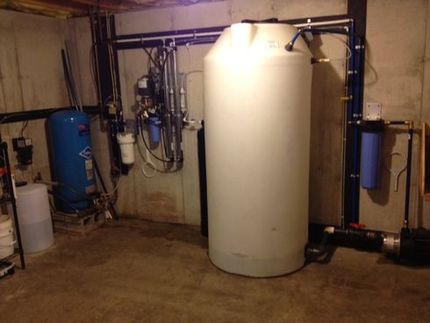 |
|---|
|
Overview of the entire installation. The large blue tank at left is the pressure tank for the well--not part of the RO system. All treatment except chemical injection is done after the well tank. Water enters from the left and is injected with a conditioning chemical to protect the RO membranes from hardness. It then passes through the white sediment filter, then the smaller blue sediment filter. These protect the membrane from damage by particles larger than 5 microns. Water is then pressurized to just under 200 psi and sent through the RO membranes (the two vertical stainless cylinders). After the RO treatment, water goes to the black filter peeping from behind the larger tank. It is a calcite tank that raises the pH and adds a bit of mineral back into the very low TDS RO water. From there, it is stored in the 300 gallon storage tank. Treated water leaves the storage tank at the bottom and is pumped to the home on demand by the Grundfos pump (extreme right) via the polishing carbon block filter that assures extra clean, great-tasting water.
|
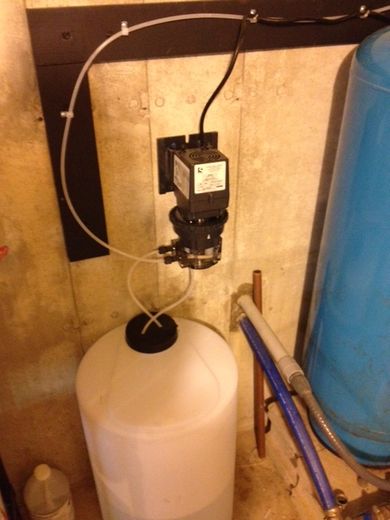 |
Pretreatment. Because the water is very hard and untreated hardness would destroy the RO membranes, the water is pretreated with a high performance antiscalant called Spectraguard. Spectraguard is so concentrated that the small bottle at lower left in the picture will last for months. The Stenner peristaltic pump that feeds it will deliver as little as 0.2 gallons of highly diluted solution in 24 hours of continuous operation. The pump picks up the diluted Spectraguard from the solution tank and pressure feeds it into the water line that feeds the RO unit. |
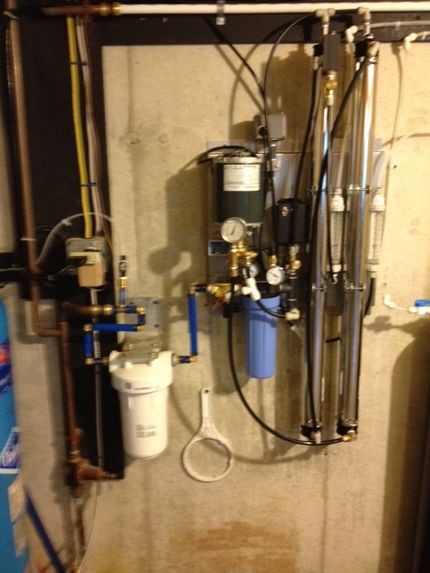 |
| Watts R12 Reverse Osmosis Unit, The white and blue vessels prefilter the water for sediment. The water is then pressurized and fed to the two stainless steel membrane housings. Efficiency is increased by directing the brine (reject water) of membrane #1 into membrane #2 as its feed water. An additional recycle feature allows part of the brine to be reintroduced into membrane #1. Glass flow meters (hard to see in the picture) measure the brine and permeate output of the unit. |
After the water leaves the RO unit in a 3/8" tube, it passes through a calcite tank to remineralize it and increase the pH. The calcite tank (not pictured) is a simple upflow unit that requires no electricity or backwashing.
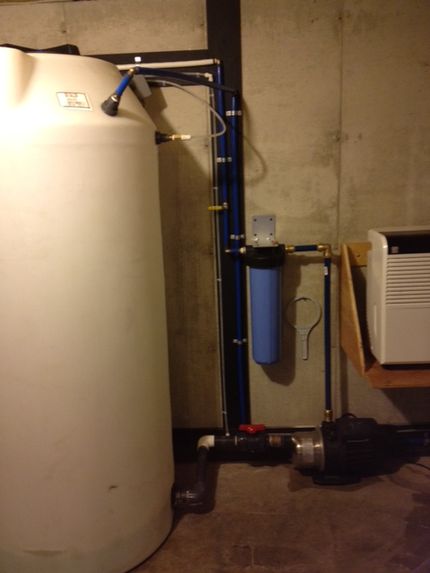 |
|---|
| Storage and Delivery. After the calcite tank, water enters the 300 gallon storage tank at the top. It exits from the bottom of the tank and is delivered to the home by the smooth operating Grundfos MQ3 delivery pump. A float valve in the tank turns the RO unit off when the tank is full and starts it when the water drops below a preset level. The tank, the pump, and the installation parts are all part of the Watts "Whole House Option" package. |
For more pictures and information about R12 units, please visit our main website.
The Pure Water Occasional is a project of Pure Water Products. Please visit our websites: Main Website: www.purewaterproducts.com This site features our full range of products, plus instructions, technical articles, product manuals, and more. The Occasional's Website: www.purewateroccasional.net. In addition to archiving back issues of the email Occasional, this site houses a sizeable section about water contaminants, a "how things work," series, a new products section, a glossary of water treatment terms, and, "much, much more." Other Pure Water Products Sites: www.purauv.com To contact us by phone, please call 940 382 3814.
|
|---|
